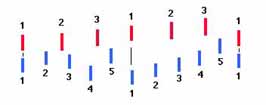
(fragment from the beginning of the the piece)
| listen to a performance model of study in 5's and 3's (REQUIRES QuickTime) |
Study
in 5's and 3's
(duration 2'30")

(fragment from the beginning of the the piece)
| listen to a performance model of
study in 5's and
3's (REQUIRES QuickTime) |
This is one of a set of compositions which is based on simultaneous streams
of complementary (metrical) movement. Study 5:3 shares many of the features
of the Invention featured a few weeks back—two or more independent voices
related to the movements of two hands, varying degrees of independence—there
is here a much more assertive, at times, quite radical autonomy between the layers.
The basic pattern of movement this:
relative independence of voices: 5/4 left hand together with 3/4 in the right

convergence: both layers or hands 5/4 transforming to independence: reverse 5/4
right hand; 3/4 left transforming again to convergence, but still 5:3 This play of
not-together/together is what generates the large-scale rhythm and form of the piece.
The natural image I have in mind is the generative chaos of rushing whitewater,
with all the whirlpools and vortices spinning about, sometimes merging, sometimes
colliding, only then to converge into one powerful, unified flow. The part of the
Western musical tradition with which Study in 5's and 3's resonates most strongly
is of course the work, especially the orchestral compositions, of Charles Ives. (You
might want to compare the score of another concert piece for piano which is also
in an abstract sense similar to Ives : (More) Like That.)